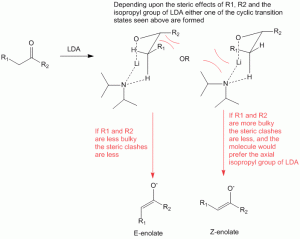The Henderson-Hasselbalch equation is widely used by many scientists especially chemists, biologists and pharmacists. We have already seen the derivation of the Henderson-Hasselbalch equation. On this page we discuss some of the applications of the Henderson-Hasselbalch equation and solve some sample problems which one may encounter in research.
Understanding unknowns which can be calculated using Henderson-Hasselbalch equation
The Henderson-Hasselbalch equation is written as:
pH = pKa + log ([A–]/[HA])
or
pH = pKa + log [(salt)/(acid)]
or
pH = pKa + log ([ionized]/[unionized])
In all the above cases the following unknowns can be calculated:
- The pH of the solution- The pH of a solution is a measure of the acidity and basicity of the solution. The dependance of many reactions, as well as biological functions depends upon the pH of the solution in which the chemistry occurs. We will see examples below where we will be able to calculate the pH of a solution of a chemical by knowing its pKa and ratio of ionized and unionized chemical.
- The pKa of a chemical in solution- The pKa of a solution determines the acidity of the compound. The pKa also determines the amount of ionization of a molecule in a solution of particular pH. Below are a few examples of calculating the pKa of a molecule using the Henderson-Hasselbalch equation.
- The [A-] or salt concentration or the amount of ionized chemical and the [HA] or acid concentration or the amount of unionized chemical- Knowing the ratio of the ionized and unionized forms of the molecule is important for certain reactions as well as for pharmaceutics related problems as a lot of biological functions such as absorption and excretion of drugs depends upon the ionized/unionized state of the drug.
Keeping in mind that the Henderson-Hasselbalch equation is useful in these three scenarios, lets take a look at certain applications and examples.
Applications and Examples of the Henderson-Hasselbalch equation
1] Calculating pH of a Solution using pKa
Knowing the pH of a solution is extremely important for many chemical reactions as well as biological systems such as enzymes and proteins. The Henderson-Hasselbalch equation can be used to calculate the pH of a solution by knowing the chemical moiety present in the solution, it’s pKa and by measuring (using some other method) the ratio of its ionized and unionized forms.
Example 1: Calculate the pH of a buffer composed of 0.1M acetic acid (CH3COOH) and 0.6M acetate (CH3COO-) knowing that the acid dissociation constant Ka is 1.8 x 10-5.
Step 1. Figure out what variables we have:
i.e we know that [HA] = [CH3COOH] = 0.1M (unionized species)
[A-] = [CH3COO-] = 0.6M (ionized species)
Ka = 1.8 x 10-5
Step 2. Analyze what we need for the Henderson-Hasselbalch equation
i.e. The Henderson-Hasselbalch equation is written as: pH = pKa + log ([A–]/[HA])
We already know the values for [A-] and [HA]. Thus we only need to convert the Ka into pKa.
Note- Make sure the units for the [A-] and [HA] are in molar (M) units. pKa = – log Ka = – log 1.8 x 10-5 = 4.7
Step 3. Insert all knowns into Henderson-Hasselbalch equation and calculate the unknown pH
pH = pKa + log ([A–]/[HA])
pH = 4.7 + log ( 0.6 / 0.1)
pH = 4.7 + log 6
pH = 4.7 + 0.78
pH = 5.48 (Answer)
Example 2: Calculate the pH of a buffer solution prepared by dissolving 363 mg of Tris in 10 mL of 0.2M HCl and diluting to 100 mL with water. [Tris: mw 121 g/mol and pKa = 8.08 for the conjugate acid]
This problem is more trickier than the example 1. In this problem we must realize that the final volume is 100mL and everything must be calculated using that as the final volume.
Step 1. Figure out what variables we have:
a) 363 mg of Tris was dissolved in a total final volume of 100 mL. Since molecular weight of tris is 121 g/mol, the concentration of total Tris is [Tris]T = 3.63/121 = 0.03M.
b) 10 mL of 0.2 M HCl was diluted to 100 mL. Therefore concentration of HCl is [HCl] = 0.02M.
c) pKa for the conjugate acid is 8.08
d) write down the chemical equation to find the conjugate acid Tris + HCl ↔ Tris.HCl
Step 2. Analyze what we need for the Henderson-Hasselbalch equation
We already know the pKa of tris i.e. 8.08. We need to know the amount of [Tris] and [Tris.HCl].
When 0.03M of Tris is dissolved in 0.02M HCl, the amount of [Tris.HCl] formed is 0.02M.
Thus the remaining [Tris] is = [Tris]T – [Tris.HCl] = 0.03 – 0.02 = 0.01M
Step 3. Insert all knowns into Henderson-Hasselbalch equation and calculate the unknown pH
pH = pKa + log ([A–]/[HA]) = pKa + log([Tris]/[Tris.HCl])
pH = 8.08 + log ( 0.01 / 0.02)
pH = 8.08+ log 0.5
pH = 8.08 – 0.30
pH = 7.78 (Answer)
2] Calculating the Ionized/Unionized Concentrations of Chemicals
The ability to calculate the ratio of ionized to unionized species of a molecule is by far the most powerful applications of the Henderson Hasselbalch equation. This ability is widely used in organic chemistry synthesis, analytical chemistry and pharmaceutical sciences especially in absorption, distribution and excretion properties. The examples below will shed some light of its usefulness.
Example 1: Aspirin (acetylsalicylic acid) has a pKa of 3.5. (i) Calculate the ratio of ionized/unionized of the drug in the stomach where pH is 1. (ii) Calculate the ratio of ionized/unionized in the intestine where pH is 6. (iii)Based on these calculations- where is aspirin absorbed within the body?
Aspirin is a commonly used drug. This problem will help you understand the utility of the Henderson Hasselbalch equation.
Step 1: Figure out the information we have:
pKa of aspirin = 3.5
pH of stomach = 1
pH of intestine = 6
Unknown = log [ionized]/[unionized].
Step 2: Analyze what we need for the Henderson Hasselbalch equation
Based on the information above- we have everything we need to solve the problem.
Step 3: Insert all knowns and calculate the unknowns to answer the subquestions:
Let us answer each subquestion individually:
(i) Write down the Henderson-Hasselbalch equation for stomach
pH of stomach = pKa of aspirin + log [ionized]/[unionized]
The pH of the stomach is maintained constant by proton pumps within the body and hence can be assumed to be 1.
Thus fitting the known values of pH and pKa we get:
1 = 3.5 + log [ionized]/[unionized]
log [ionized]/[unionized] = 1-3.5
log [ionized]/[unionized] = -2.5
thus, [ionized]/[unionized] = Antilog (-2.5)
[ionized]/[unionized] = 0.00316 (Answer)
From the above value it means that for every 3 ionized molecules in the stomach there are almost 1000 unionized molecules, suggesting that aspirin is largely unionized in the stomach (99.7% unionized).
(ii) Write down the Henderson Hasselbalch equation for the intestine:
pH of the intestine = pKa of aspirin + log [ionized]/[unionized]
Again, the pH of the intestine can be assumed to be constant as it will not undergo a change with the aspirin:
6 = 3.5 + log [ionized]/[unionized]
log [ionized]/[unionized]= 6 – 3.5
log [ionized]/[unionized] = 2.5
[ionized]/[unionized] = Antilog (2.5)
[ionized]/[unionized] = 316.2 (Answer)
From the above value, it means that for 316 ionized molecules of aspirin in the intestine there is only 1 unionized molecule, suggesting that aspirin is largely ionized in the intestine (99.7% ionized).
(iii) Unionized molecules are more lipophilic than ionized molecules. In our body, absorption via oral route normally occurs when the drug is in the unionized state, as unionized molecules are lipophilic enough to cross the cell membrane. In the case of aspirin, which is an acidic molecule, based on the above calculations we can see that it is more unionized in the stomach than in the intestine. Thus majority of the aspirin is absorbed via the stomach under acidic pH.
Note- The same type of calculation can be done for organic chemistry – to find out the distribution of a molecule between different phases at different pH, and for analytical chemistry to identify appropriate buffers to maintain the molecules in unionized or ionized state.
3] Calculating pKa of a Molecule using pH
The pKa of a molecule is an important characteristic of the chemistry of the structure of the molecule. The Henderson-Hasselbalch equation can be utilized to calculate the pKa of a molecule using the chemical moiety present in the solution, pH of the solution and by measuring (using some other method) the ratio of its ionized and unionized forms. Thus this type of calculation requires experimental measurements in the form of measurement of ionic and unionic forms of the molecule. Generally the amount of ionized and unionized species is detected using some spectroscopic technique.




This is so helpful! among all the articles I’ve read. Very simplified but well explained. thank you! =)
When 0.03M of Tris is dissolved in 0.02M HCl, the amount of [Tris.HCl] formed is 0.02M.
i couldnt get ths line why is this equal to 0.02 M ?
This is because HCl is the limiting reagent in the formation of Tris.HCl and 0.03M Tris is the excess reagent. You can only form 0.02M Tris.HCl as you are using 0.02M HCl.
VERY well explained, thank you! This clicked for me more than two semesters of undergrad did.
Thanks
it is better to makes the subjects as download PDF
Amazing,thanks for the explanation
thanks _well understood
Brilliant stuff! Well explained.